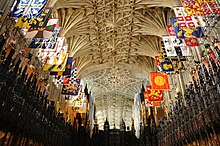
The Most Noble Order of the Garter is an order of chivalry founded by Edward III of England in 1348. The most senior order of knighthood in the British honours system, it is outranked in precedence only by the decorations of the Victoria Cross and the George Cross. The Order of the Garter is dedicated to the image and arms of Saint George, England's patron saint.

Grinling Gibbons was an Anglo-Dutch sculptor and wood carver known for his work in England, including Windsor Castle, the Royal Hospital Chelsea and Hampton Court Palace, St Paul's Cathedral and other London churches, Petworth House and other country houses, Trinity College, Oxford and Trinity College, Cambridge. Gibbons was born to English parents in Holland, where he was educated.

Prince Arthur of Connaught was a British military officer and a grandson of Queen Victoria. He served as Governor-General of the Union of South Africa from 20 November 1920 to 21 January 1924.

The Most Honourable Order of the Bath is a British order of chivalry founded by King George I on 18 May 1725. Recipients of the Order are usually senior military officers or senior civil servants, and the monarch awards it on the advice of His Majesty's Government. The name derives from an elaborate medieval ceremony for preparing a candidate to receive his knighthood, of which ritual bathing was an element. While not all knights went through such an elaborate ceremony, knights so created were known as "knights of the Bath".

The Most Ancient and Most Noble Order of the Thistle is an order of chivalry associated with Scotland. The current version of the order was founded in 1687 by King James VII of Scotland, who asserted that he was reviving an earlier order. The order consists of the sovereign and sixteen knights and ladies, as well as certain "extra" knights. The sovereign alone grants membership of the order; they are not advised by the government, as occurs with most other orders.

The Royal Victorian Order is a dynastic order of knighthood established in 1896 by Queen Victoria. It recognises distinguished personal service to the monarch, members of the royal family, or to any viceroy or senior representative of the monarch. The present monarch, King Charles III, is the sovereign of the order. The order's motto is Victoria. The order's official day is 20 June. The order's chapel is the Savoy Chapel in London.

The Henry VII Lady Chapel, now more often known just as the Henry VII Chapel, is a large Lady chapel at the far eastern end of Westminster Abbey, England, paid for by the will of King Henry VII. It is separated from the rest of the abbey by brass gates and a flight of stairs.

A crest is a component of a heraldic display, consisting of the device borne on top of the helm. Originating in the decorative sculptures worn by knights in tournaments and, to a lesser extent, battles, crests became solely pictorial after the 16th century.

Sir William Reid Dick, was a Scottish sculptor known for his innovative stylisation of form in his monument sculptures and simplicity in his portraits. He became an Associate of the Royal Academy in 1921 and a Royal Academician in 1928. Dick served as president of the Royal Society of British Sculptors from 1933 to 1938. He was knighted by King George V in 1935. He was Sculptor in Ordinary for Scotland to King George VI from 1938 to 1952, then held the post under Queen Elizabeth until his death in 1961.

An order of chivalry, order of knighthood, chivalric order, or equestrian order is an order of knights, typically founded during or inspired by the original Catholic military orders of the Crusades and paired with medieval concepts of ideals of chivalry.

Windsor Castle is a royal residence at Windsor in the English county of Berkshire. It is strongly associated with the English and succeeding British royal family, and embodies almost a millennium of architectural history.

Sir Edgar Bertram Mackennal, usually known as Bertram Mackennal, was an Australian sculptor and medallist, most famous for designing the coinage and stamps bearing the likeness of George V. He signed his work "BM".
Edward Bainbridge Copnall was a British sculptor and painter. Best known for his architectural and decorative sculptures featuring allegorical and religious subjects. He was the President of the Royal Society of Sculptors from 1961 to 1966.

St George's Chapel at Windsor Castle in England is a castle chapel built in the late-medieval Perpendicular Gothic style. It is a Royal Peculiar, and the Chapel of the Order of the Garter. St George's Chapel was founded in the 14th century by King Edward III and extensively enlarged in the late 15th century. It is located in the Lower Ward of the castle.
Phil R. White is a Canadian artist and sculptor. He is the Dominion Sculptor of Canada, a position whose duties include the creation of original works of art in sculpture. His works are primarily in figurative art. He is an architectural sculptor and carver and creates works in stone, wood, and bronze.

The equestrian statue of Charles I at Charing Cross, London, England, is a work by the French sculptor Hubert Le Sueur, probably cast in 1633 during Charles’ lifetime. It is the oldest bronze statue in London and is considered the central point of the city.

The Thistle Chapel, located in St Giles' Cathedral, Edinburgh, Scotland, is the chapel of the Order of the Thistle.

The King George VI Memorial Chapel is part of St George's Chapel at Windsor Castle in England. The chapel was commissioned by Elizabeth II in 1962 as a burial place for her father, George VI, and was completed in 1969. It contains the final resting places of King George VI, Queen Elizabeth The Queen Mother, Queen Elizabeth II, Prince Philip, Duke of Edinburgh, and the ashes of Princess Margaret. It was designed by George Pace.

















